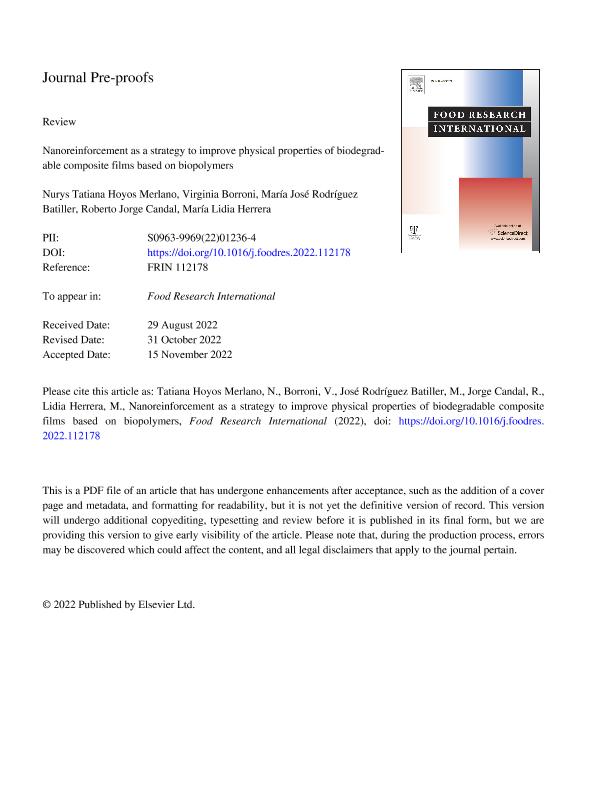Mostrar el registro sencillo del ítem
dc.contributor.author
Hoyos Merlano, Nurys Tatiana

dc.contributor.author
Borroni, Maria Virginia

dc.contributor.author
Rodríguez Batiller, María Jose

dc.contributor.author
Candal, Roberto Jorge

dc.contributor.author
Herrera, Maria Lidia

dc.date.available
2023-07-17T18:30:21Z
dc.date.issued
2022-12
dc.identifier.citation
Hoyos Merlano, Nurys Tatiana; Borroni, Maria Virginia; Rodríguez Batiller, María Jose; Candal, Roberto Jorge; Herrera, Maria Lidia; Nanoreinforcement as a strategy to improve physical properties of biodegradable composite films based on biopolymers; Elsevier Science; Food Research International; 162; 112178; 12-2022; 1-53
dc.identifier.issn
0963-9969
dc.identifier.uri
http://hdl.handle.net/11336/204227
dc.description.abstract
Food packaging is evolving from inert plastic to renewable biopolymer film that acts as barrier against gases, light radiation, and microorganisms, reducing food waste without environmental damage. Distinct starting systems were selected to prepare films: single polymer matrix, blend of polymers, cross-linked polymers, and emulsion-based matrix. The blend of polymers was one of the best approaches to improve mechanical and barrier properties of films, especially when one of the polymers was pectin, gelatin or xanthan gum. These polymers can form a gel and increase the viscosity of the starting systems leading to a more elastic matrix. Although some of these films showed potential to replace plastic materials, their physical properties were poor compared to plastics. Thus, several strategies were used to strengthen matrix building block connections or interactions between nanoreiforcement and matrix compounds with the aim of improving physical properties. Among metal oxides, TiO2, ZnO, CaO, and MgO were the most studied, alone or in combinations with other reinforcements. Natural fillers, like chitosan and cellulose nanofibers were also added to improve the biopolymer's performance. Several of these systems successfully extended the shelf life of food systems by retarding spoilage, showing great potential to improve food quality and reduce waste. However, most of the studies were carried out on a laboratory scale and it would be necessary to explore the feasibility of producing these films on an industrial scale.
dc.format
application/pdf
dc.language.iso
eng
dc.publisher
Elsevier Science

dc.rights
info:eu-repo/semantics/openAccess
dc.rights.uri
https://creativecommons.org/licenses/by-nc-nd/2.5/ar/
dc.subject
CROSS-LINKING
dc.subject
FILMS
dc.subject
MATRIX
dc.subject
METAL OXIDES
dc.subject
NANOLOAD
dc.subject
NATURAL FILLERS
dc.subject.classification
Nano-materiales

dc.subject.classification
Nanotecnología

dc.subject.classification
INGENIERÍAS Y TECNOLOGÍAS

dc.title
Nanoreinforcement as a strategy to improve physical properties of biodegradable composite films based on biopolymers
dc.type
info:eu-repo/semantics/article
dc.type
info:ar-repo/semantics/artículo
dc.type
info:eu-repo/semantics/publishedVersion
dc.date.updated
2023-06-30T12:28:42Z
dc.journal.volume
162
dc.journal.number
112178
dc.journal.pagination
1-53
dc.journal.pais
Países Bajos

dc.journal.ciudad
Amsterdam
dc.description.fil
Fil: Hoyos Merlano, Nurys Tatiana. Consejo Nacional de Investigaciones Científicas y Técnicas. Oficina de Coordinación Administrativa Houssay. Instituto de Tecnología en Polímeros y Nanotecnología. Universidad de Buenos Aires. Facultad de Ingeniería. Instituto de Tecnología en Polímeros y Nanotecnología; Argentina
dc.description.fil
Fil: Borroni, Maria Virginia. Consejo Nacional de Investigaciones Científicas y Técnicas. Oficina de Coordinación Administrativa Houssay. Instituto de Tecnología en Polímeros y Nanotecnología. Universidad de Buenos Aires. Facultad de Ingeniería. Instituto de Tecnología en Polímeros y Nanotecnología; Argentina
dc.description.fil
Fil: Rodríguez Batiller, María Jose. Consejo Nacional de Investigaciones Científicas y Técnicas. Oficina de Coordinación Administrativa Houssay. Instituto de Tecnología en Polímeros y Nanotecnología. Universidad de Buenos Aires. Facultad de Ingeniería. Instituto de Tecnología en Polímeros y Nanotecnología; Argentina
dc.description.fil
Fil: Candal, Roberto Jorge. Universidad Nacional de San Martín. Instituto de Investigación en Ingeniería Ambiental; Argentina. Universidad Nacional de San Martín. Instituto de Investigación e Ingeniería Ambiental. - Consejo Nacional de Investigaciones Científicas y Técnicas. Oficina de Coordinación Administrativa Parque Centenario. Instituto de Investigación e Ingeniería Ambiental; Argentina
dc.description.fil
Fil: Herrera, Maria Lidia. Consejo Nacional de Investigaciones Científicas y Técnicas. Oficina de Coordinación Administrativa Houssay. Instituto de Tecnología en Polímeros y Nanotecnología. Universidad de Buenos Aires. Facultad de Ingeniería. Instituto de Tecnología en Polímeros y Nanotecnología; Argentina
dc.journal.title
Food Research International

dc.relation.alternativeid
info:eu-repo/semantics/altIdentifier/url/https://www.sciencedirect.com/science/article/pii/S0963996922012364
dc.relation.alternativeid
info:eu-repo/semantics/altIdentifier/doi/http://dx.doi.org/10.1016/j.foodres.2022.112178
Archivos asociados
